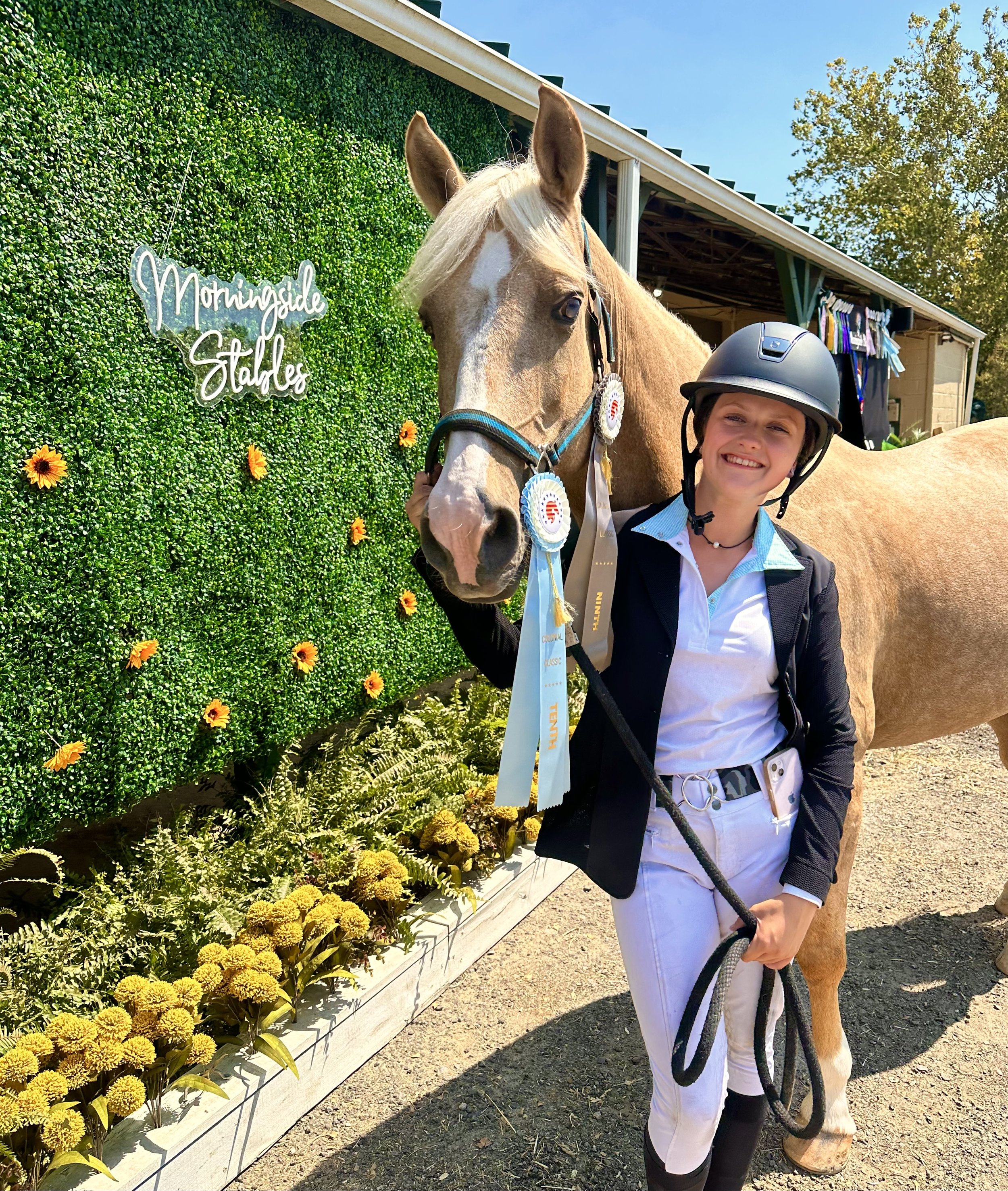Riding Gear & Equipment
WHAT TO BUY
Horseback riding involves a lot of equipment, and it can get confusing. This guide can help you decide what you need.
We hope this guide helps you determine what is appropriate for yourself or your kid/s and can help you make the best possible solutions for riding! Keep reading to find information carefully tailored for new riders, advanced riders, and members of our show team who travel to shows and compete. Please consult your instructor for any questions, or before purchasing new equipment.
Tack Shops in Maryland
Maryland Saddlery (Crofton and Butler, MD - *mention Morningside Stables for a discount*)
Dover Saddlery (Crofton and Hunt Valley, MD)
Anytime Tack (Silver Spring, MD)
Stablemates, Inc. (Mt. Airy, MD)
For new riders
For the rider who’s just getting started with lessons, or is unsure whether or not they want to take lessons consistently, this is what you need for safe and successful lessons.
Helmet: We require that all riders have an ASTM/SEI certified helmet whenever mounted. These can be purchased at any tack shop, or even online for as little as $50. However, we recommend going to a store to be properly fitted. Helmets can be any color, and many come in bright colors/patterns. Our favorite helmets for new riders are Ovation and Tipperary.
Close-toed shoes with a heel: The ideal boot for horseback riding is a proper riding boot, such as a paddock boot (pictured below.) This allows for the rider’s foot to be properly, safely, and securely placed in the stirrup. When paddock boots are not an option, shoes such as chelsea boots, tall riding-style boots, lowkey boots, and sneakers can work. Boots with a deep tread, heel of taller than one inch, or large profile do NOT work well. Ariat is the best brand to begin with.
Long pants: We also require long pants for all mounted activity. Jeans and leggings work extremely well. Tights are not recommended as they are thin and may quickly wear holes. If desired, proper riding pants are comfortable, durable, and perform best for riders.
Our top picks
For continuing riders
For riders who have been regularly taking lessons and are committed to riding, leasing, or advancing their skills - this equipment is worth the investment to complement your riding journey.
Half chaps: Half chaps are designed to simulate the feeling and look of a tall boot or field boot. These provide an extra-secure grip for the rider’s leg against the saddle/horse, improving security and stability. We recommend purchasing half chaps in dark neutral colors (brown or black) but they also come in fun colors!
Gloves: Some riders strongly prefer to ride in gloves, while others do not mind riding without. These are particularly helpful for riders who get any callouses or who have sensitive hands. Noble Outfitters makes affordable, good quality riding gloves in all colors/patterns.
Breeches: Continuing riders should absolutely invest in some proper riding breeches. These pair well with boots and half chaps or tall boots.
Safety vest: For anybody concerned about safety, safety vests can be a wise investment. Charles Owens and Tipperary are the industry standard.
For show team riders
Here is the checklist of required gear/attire for all actively showing riders.
Non-eventing
Black helmet
Hairnet (13+, No Knot Hairnet is recommended)
Black gloves
White long sleeve (fall/winter) or short sleeve (spring/summer) show shirt
Show jacket (navy or black)
Tan jods (under 12) or breeches (13+)
Black paddock boots and garters (under 12)
Black tall boots (13+)
Belt (black or brown)
Suggested: Bows (under 12), garment bag to protect/transport clothing, boot bag to protect/transport boots, leather cleaner/conditioner/polish, lint roller, soft brush/sponge/rag for day-of cleaning
Eventing
Helmet (must be black and show quality. Ex: IRH, Charles Owen, One K, Tipperary, Trauma Void, Samshield)
Hairnet (No Knot Hairnet is recommended)
Black gloves
White long sleeve show shirt
Show jacket (navy or black)
Tan breeches
Belt (black or brown)
Black tall boots
XC Vest (any color, Tipperary or Charles Owen)
Medical armband
Optional: white breeches, other neutral colors breeches for SJ/XC phases, bright helmet covers/gloves/showshirts/belts for SJ/XC, garment bag to protect/transport clothing, boot bag to protect/transport boots, leather cleaner/conditioner/polish, lint roller, soft brush/sponge/rag for day-of cleaning
For winter weather
Wondering how to stay warm for riding in the winter?
Winter gloves: Winter gloves are a must! Unlike other gloves, winter riding gloves allow for flexibility and range of motion while also allowing the rider to grip the reins and stay warm.
Insulated riding boots: Warm, waterproof, insulated riding boots make a huge difference for anybody whose feet are getting cold while riding or while spending time in the barn. Ariat’s winter boots are the best.
Insulated winter riding pants: Softshell, fleece-lined riding pants are excellent for colder weather. They are thicker and warmer than other riding pants. Some great options include Irideon, Kerrits, and Horze.
Layers, layers, layers: Layering while riding is super important when it’s cold! A baselayer covered with warm outlayers, such as fleece for insulation and a windbreaker/rain jacket for inclement weather work very well as riders do tend to warm up once riding, even in extremely cold weather. You can also layer your pants - put warm leggings under your jeans or breeches to stay extra warm, or you can even double up on socks. Neck gaiters (fleece, merino wool) are great for keeping your neck warm while riding as well.
For the cold sensitive: For anybody who gets extremely cold and just can’t stand it, insulated winter overpants are a great solution. These are waterproof and extremely warm. They look and feel like snowpants but are built for riding. You can also order ear muffs to strap to your helmet to keep your ears/head warm - you can find them on sites like Etsy or Foxy Equestrian.



